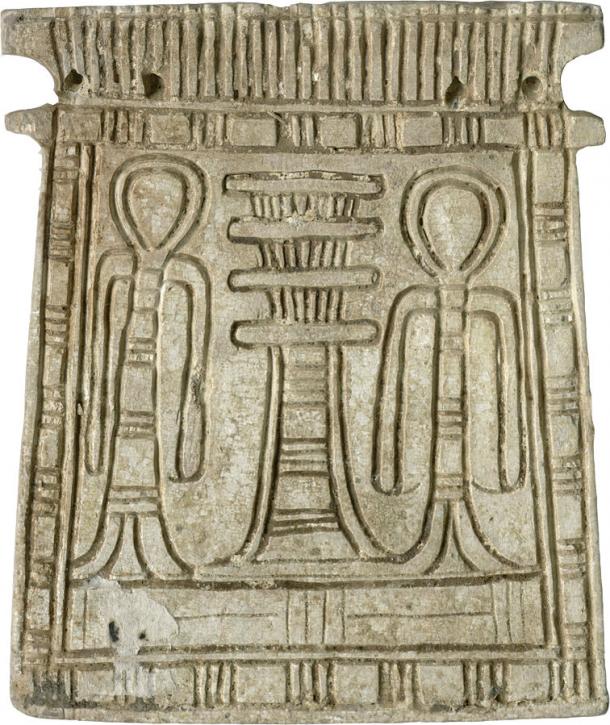🔴 Website 👉 https://u-s-news.com/
Telegram 👉 https://t.me/usnewscom_channel
Hieroglyphics play an important role in understanding ancient Egyptian culture. One of the most commonly found and mysterious hieroglyphic symbols is known as the djed symbol. With the appearance of a pillar and three or more cross bars, there have been several theories as to the meaning of this enigmatic symbol, and what it represented to the ancient Egyptians who used it so frequently.
Alternate Interpretations and Fertility Symbolism
The djed symbol has the appearance of a vertical shaft or pillar. It usually had four horizontal bars near the top, with a series of vertical lines between each bar. It also had four bands around the neck of the shaft, beneath the first of the horizontal bars. Sometimes it is topped with a capital.
A djed pillar (center) on a glazed steatite pectoral (1070 – 703 BC). (Public Domain)
Many believe the djed is a symbol of the god Osiris, specifically, his spine. According to Egyptian mythology, Osiris was the god of the afterlife. While visiting Set, the god of disorder, desert, storms, and violence, Osiris was tricked into climbing into a coffin that was built exactly to his size. He was quickly suffocated, and the coffin was cast into the Nile. Eventually, the coffin washed up on the shores of Byblos, in Syria. A sacred tree grew rapidly around the coffin, encasing the coffin within its trunk.
The king of the land, unaware of the presence of the coffin, was in awe of the tree’s quick growth, and he ordered it cut down to become a pillar in his palace. All the while, Osiris’ wife Isis had been searching for him. She came to learn that his body was contained inside the pillar. She became close with the king and queen, and when they granted her a boon, she requested the pillar. Upon being granted the pillar, she removed Osiris’ body and consecrated the pillar. It has since been called the pillar of the djed.
The sun disk of the god Ra is raised into the sky by an ankh-sign (signifying life) and a djed-pillar (signifying stability and the god Osiris) while adored by Isis, Nephthys, and baboons. The motif symbolizes rebirth and the sunrise. (Public Domain)
According to others, the djed is a fertility pillar made from or surrounded by reeds, trees, or sheaves. As Egypt was a treeless land, this may represent the importance of the trees that were imported from Syria. This also ties in with the story of Osiris, where his body was encased within the trunk of a tree. Other accounts associate the djed with the falcon god of the Memphite necropolis, Seker, then with the Memphite patron god of craftsmen Ptah. Ptah is sometimes referred to as “the noble djed.” The djed symbol is also sometimes viewed as a pillar supporting the sky. In a palace, the pillars may surround a window, and when viewed from the right angle, it appears that the pillars are supporting the sky.
Stucco relief of Ptah holding a staff that bears the combined ankh and djed symbols. Late Period or Ptolemaic Dynasty, 4th to 3rd century BC. (One dead president/CC BY-SA 3.0)
The djed symbol is also used in a ceremony called “raising the djed.” This ceremony is meant to represent Osiris’ triumph over Set. During the ceremony, the pharaoh uses ropes to raise a pillar, with the assistance of priests. This coincided with the time of year when the agricultural year began, and fields were sown. This was just one part of a 17-day holiday of festivals dedicated to Osiris. Overall, the raising of the djed ceremony represented both the resurrection of Osiris, and the strength and stability of the monarch.
Raising the Djed pillar, Temple of Seti I, Abydos, Egypt (Roland Unger/CC BY-SA 3.0)
The djed has also been used as an amulet, placed near the spines of mummified bodies, and the image painted on their coffin. The amulet was intended to allow the deceased to live eternally, and to ensure their resurrection.
The Egyptian Book of the Dead contains a spell that would be spoken as the amulet was placed on the mummy, in hopes that it would allow the deceased to sit up and regain use of their spine. In addition, it was often seen in hieroglyphic inscriptions and even as part of architectural structures. Its ubiquitous appearance gives the impression that this symbol was both important and sacred in ancient Egyptian belief systems.
The djed symbol seen in hieroglyphic inscription at Deir el-Bahri. (Kyera Giannini / CC BY 2.0)
The djed symbol embodies key themes of resurrection, stability, and fertility in ancient Egyptian beliefs. Its connection to Osiris and rituals like the “raising of the djed” reflects its cultural significance. As a sacred emblem and protective amulet, it showcases the Egyptians’ reverence for life and the afterlife. Its frequent appearance in hieroglyphics and architecture highlights its enduring importance in ancient Egyptian civilization.
Top image: A scene on the west wall of the Osiris Hall that is situated beyond the seven chapels and entered via the Osiris Chapel. It shows the raising of the Djed pillar. Source: Jon Bodsworth/ Copyrighted free use
By M R Reese
